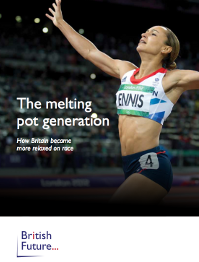Who are we? Census 2011 reports on ethnicity in the UK
Runnymede Trust: Intelligence for a multi-ethnic Britain
2012-12-11
Dr. Omar Khan, Head of Policy Research
Every ten years the Census provides us with multiple insights into the state of modern Britain. In today’s release of the 2011 Census, we find that the Black and minority ethnic (BME) population has reached nearly 8 million – roughly the population of Scotland and Wales combined.
Overall, the BME population is now 14.1% of the overall total in England and Wales, rising from 7.9% in 2001. This doesn’t include the significant ‘White Other’ population which is now 2.5 million, or 4.4% of the overall population. Much of this growth has been through immigration, and many will assume that the ‘White Other’ population is primarily Eastern European. However, this population also includes White French, White Australian, White Argentinian and White American people, which explains why this disparate ‘group’ is now some 12.6% of the population of London.
Combined with the 40% of the population that is Black and minority ethnic, a minority of London’s residents are now ‘White British’ (46%). While this is indeed a striking development, it masks an arguably more significant development – the greater dispersal of ethnic minorities across the UK. Contrary to much received wisdom, Britain is becoming less ‘segregated’ every year.
Between 2001 and 2011, the regions whose BME population has grown the fastest are those that had the fewest ethnic minorities in 2011. So Wales, the North East and South West have all doubled their proportion of BME people (from just over 2% to over 4%), while London and West Midlands, which had the most BME people in 2001, have grown the slowest. There are more BME people living across the UK, including in villages and the countryside, and this phenomenon can be expected to continue.
One of the striking findings of the census is the reduction in the overall number of ‘White British’ people by over half a million people. So one reason the BME proportion of the population is rising is because the White British population is shrinking. In most regions of England and Wales this decrease or growth was actually quite minimal (with the White British population growing by more than 2% over the decade only in the South East), but London was notable because there were 600,000 fewer White British people living there in 2011 compared to 2001. This clearly points to the phenomenon of White British people leaving the capital, and explains much of the rise in London’s proportion of BME people…
…Inevitably much coverage of the census will focus on the rising ‘Mixed’ population, which now is the second largest, at some 1.2 million people. While the rise in the number of people categorized as mixed has been quite remarkable, so too has the overall BME growth, meaning that the ‘Mixed’ population is only 1% more (15.6%) of the total BME population than it was in 2001 (14.6%)…
…On most social outcome measures, the ‘Mixed’ population shows enormous variation, with Black Caribbean-White and Black African-White people more likely to have outcomes similar to Black people generally. In other words, rather than viewing the ‘mixed’ population as a single group with shared social experiences, we should rather focus on the continued salience of race, and in particular how the racial background of parents affects the social outcomes of children…
…It is also significant that many of these categories have large and growing populations. This raises the final important question – how identity shifts over people’s lifetimes and indeed across generations. While the overall share of Black people within the BME population remained about a quarter, there was a sharp decrease in the proportion who identified as ‘Black Caribbean’. However, the ‘Black Other’ group saw the steepest rise, suggesting that some children of Black Caribbean parents are happier with this ethnic identity.
Depending on how identity and social experiences change, we might expect further development of the current census categories. For example, the children of White Polish parents may plausibly identify as ‘White British’, as many of the grandchildren of Irish and Italian migrants now do, while many ‘Mixed’ people may rather identify as one of their parents. Here it’s worth emphasizing again the importance of social experiences and social outcomes in understanding race and ethnicity. That Barack Obama self-identifies as African American rather than ‘Mixed’ has probably little to do with a rejection of his mother’s heritage or a radical kind of separatist politics. Rather, Obama’s identity is informed by his social experience, and the reality of racism is evidenced not simply in his experiences in the 1970s or 1980s, but in the continued focus on his place of birth and by the fact that over 90% of White American voters in Mississippi and Alabama voted for his opponent.
So while it is important to understand self-identification in thinking about race and ethnicity, people cannot simply choose an identity of their own making, nor can they escape the views and prejudices in others in navigating the world. In the UK, the unemployment rate for Black young men is now 55%, Chinese graduates with better results have lower earnings than their White colleagues and Black and Asian women face such difficult experiences in the labour market that some of them change their names on their CVs…
Read the entire article here.


